
The Royal Borough of Kensington and Chelsea is an Inner London borough with royal status. It is the smallest borough in London and the second smallest district in England; it is one of the most densely populated administrative regions in the United Kingdom. It includes affluent areas such as Notting Hill, Kensington, South Kensington, Chelsea, and Knightsbridge.

Chelsea is an affluent area in West London, England, due south-west of Charing Cross by approximately 2.5 miles (4 km). It lies on the north bank of the River Thames and for postal purposes is part of the south-western postal area.

The Thames Embankment is a work of 19th-century civil engineering that reclaimed marshy land next to the River Thames in central London. It consists of the Victoria Embankment and Chelsea Embankment.
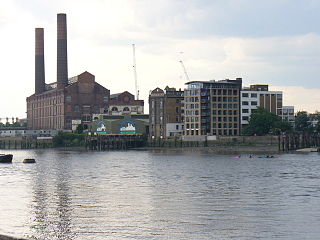
Counter's Creek, ending in Chelsea Creek, the lowest part of which still exists, was a stream that flowed from Kensal Green, by North Kensington and flowed south into the River Thames on the Tideway at Sands End, Fulham. Its remaining open watercourse is the quay of Chelsea Creek.
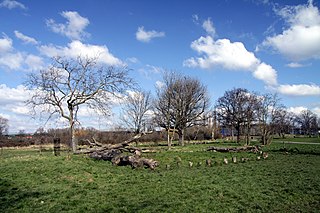
Little Wormwood Scrubs is a park in Kensal Green on the border of Hammersmith and Fulham and Royal Borough of Kensington and Chelsea. Counter's Creek, a now subterranean stream that arises in Kensal Green flows south through the park, eventually joining the River Thames.

Fulham Road is a street in London, England, which comprises the A304 and part of the A308.

Brompton, sometimes called Old Brompton, survives in name as a ward in the Royal Borough of Kensington and Chelsea in London. Until the latter half of the 19th century it was a scattered village made up mostly of market gardens in the county of Middlesex. It lay southeast of the village of Kensington, abutting the parish of St Margaret's, Westminster at the hamlet of Knightsbridge to the northeast, with Little Chelsea to the south. It was bisected by the Fulham Turnpike, the main road westward out of London to the ancient parish of Fulham and on to Putney and Surrey. It saw its first parish church, Holy Trinity Brompton, only in 1829. Today the village has been comprehensively eclipsed by segmentation due principally to railway development culminating in London Underground lines, and its imposition of station names, including Knightsbridge, South Kensington and Gloucester Road as the names of stops during accelerated urbanisation, but lacking any cogent reference to local history and usage or distinctions from neighbouring settlements.

Cremorne Gardens were popular pleasure gardens by the side of the River Thames in Chelsea, London. They lay between Chelsea Harbour and the end of the King's Road and flourished between 1845 and 1877; today only a vestige survives, on the river at the southern end of Cheyne Walk.

Chelsea Bridge Road is the modern eastern boundary of Chelsea, in the Royal Borough of Kensington and Chelsea, London, England. To the northeast is the district of Pimlico in the City of Westminster.
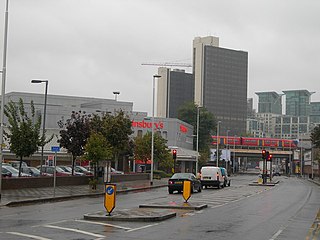
The A3036 is an A road in London, England, running from Waterloo to Wandsworth.

Royal Hospital Road is a street in Chelsea, London, England. It runs between Chelsea Embankment on the north bank of the River Thames to the southwest and a junction with Lower Sloane Street, Pimlico Road and Chelsea Bridge Road to the northeast. Also adjacent are Tite Street to the south and Flood Street to the north. The road is designated the B302. The closest tube station is Sloane Square to the north along Lower Sloane Street.
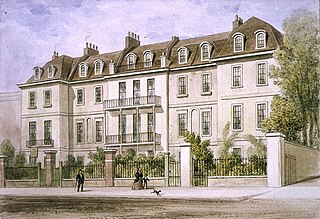
Lindsey House is a Grade II* listed villa in Cheyne Walk, Chelsea, London. It is owned by the National Trust but tenanted and only open by special arrangement.

Ladbroke Square is a garden square in Notting Hill, west London, England.

Emslie Horniman's Pleasance is a park in Kensal Town, in the Borough of Kensington and Chelsea, London. It is named after Emslie John Horniman the MP for Chelsea who created it. It opened in 1914. The park is the traditional starting point for the Notting Hill Carnival.
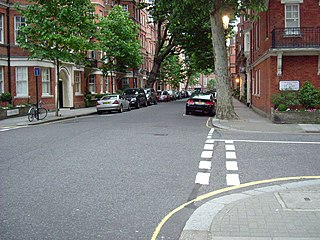
Flood Street is a residential street in Chelsea, London, England. It runs between King's Road to the north and Royal Hospital Road to the south. Just further to the south is the River Thames. The closest tube station is Sloane Square to the northeast. The street commemorates Luke Thomas Flood, a major Chelsea land owner and a benefactor of the poor.

Swan House is a Grade II* listed house at 17 Chelsea Embankment on the north bank of the River Thames in Chelsea, central London, England. Built in 1876 by the architect Richard Norman Shaw, architecturally it is relevant both to the Queen Anne Revival and to the Arts and Crafts movement. It was built by Shaw for the artistic patrons Wickham and Elizabeth Flower. Jones and Woodward, in their Guide to the Architecture of London, consider Swan House to be the "finest Queen Anne Revival domestic building in London."

Garden Corner is a Grade II* listed house at 13 Chelsea Embankment, Chelsea, London.
William Webster was a British builder who worked with architects and engineers such as Gilbert Scott and Joseph Bazalgette and is especially associated with several embankments of the River Thames.
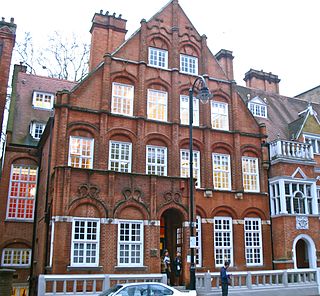
Harrington Gardens is a street which has a communal garden regionally sometimes known as a garden square in the Royal Borough of Kensington and Chelsea in London. The street runs from Collingham Gardens and Collingham Road in the east to Gloucester Road and Stanhope Gardens in the west. It is crossed by Ashburn Place and joined by Colbeck Mews on its north side. It contains several listed buildings including an important group of grade II* buildings on the south side numbered 35 to 45.

Oakley Street is in the Royal Borough of Kensington and Chelsea, London. It runs roughly north to south from King's Road to the crossroads with Cheyne Walk and the River Thames, where it continues as the Albert Bridge and Albert Bridge Road. The street was named after Baron Cadogan of Oakley.
























